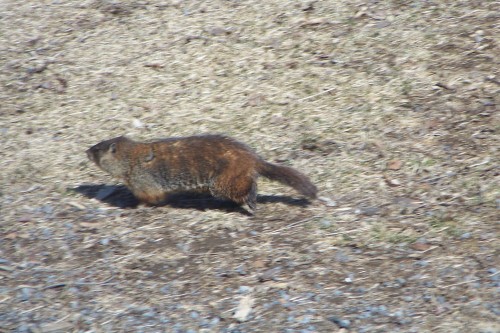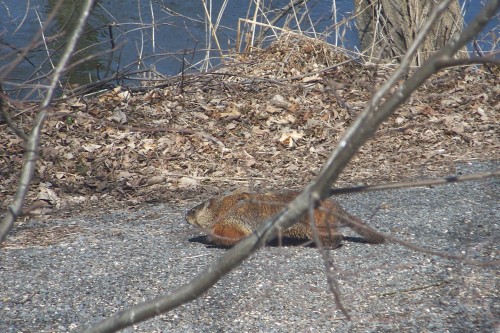
Groundhog Day is celebrated on February 2nd, but no self-respecting groundhog would be seen above ground at that time of the year. Groundhogs (Marmota monax), also know as woodchucks, are true hibernators. They settle down for their long winter’s nap around October and don’t reappear until the time of new plant growth is near. On Saturday, a movement caught my eye when I chanced to glance out the window and I was surprised to see this groundhog investigating the yard. Groundhogs are most commonly seen close to their burrows, ready to make a quick dive for safety should danger arise. This fellow, or maybe it was a female, was actively reconnoitring the area. After making a large circuit of the yard, the groundhog headed off along the river, galloping more quickly than I would have credited likely for such a sturdy body.

Groundhogs are large rodents. Their strong front teeth, like those of beavers, never stop growing, (except during hibernation), and they keep them trimmed by gnawing. They have powerful claws and are major hole diggers. Their burrows usually include a main entrance and one or more spy-holes for safety. A nest chamber, for sleeping, hibernating and raising young, is padded with dried grasses. A separate chamber serves as a toilet area. Groundhog burrows are a source of homes for other animals such as rabbits, skunks and snakes.

Young groundhogs are born around May. Litters usually number 4 or 5 young, who are born blind and helpless. By 28 days their eyes are open and they are covered with short hair. They begin to emerge from the burrow at about 6 weeks of age as they are weaned onto the groundhog’s vegetarian diet of wild plants and grasses. Their mother continues to watch over them and protect them as they grow. In the fall, older groundhogs usually enter hibernation first, the youngsters perhaps needing long to build up their fat level. The body temperature of a hibernating groundhog may drop to 3° C and the heartrate lowers from about 80 beats per minute to just 4 or 5.

Groundhogs are occasionaly melanistic (black) or albino. Ontario’s most famous groundhog is Wiarton Willie, an albino prognosticator seen here in CBC coverage of Groundhog Day, 2009.
